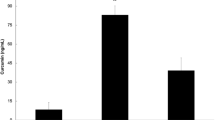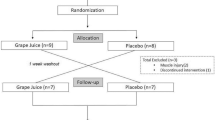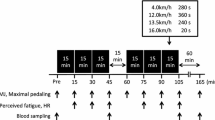Abstract
The aim of this study was to evaluate the effect of carbohydrate supplementation on free plasma DNA and conventional markers of training and tissue damage in long-distance runners undergoing an overload training program. Twenty-four male runners were randomly assigned to two groups (CHO group and control group). The participants were submitted to an overload training program (days 1–8), followed by a high-intensity intermittent running protocol (10 × 800 m) on day 9. The runners received maltodextrin solution (CHO group) or zero energy placebo solution as the control equivalent before, during, and after this protocol. After 8 days of intensive training, baseline LDH levels remained constant in the CHO group (before: 449.1 ± 18.2, after: 474.3 ± 22.8 U/L) and increased in the control group (from 413.5 ± 23.0 to 501.8 ± 24.1 U/L, p < 0.05). On day 9, LDH concentrations were lower in the CHO group (509.2 ± 23.1 U/L) than in the control group (643.3 ± 32.9 U/L, p < 0.01) post-intermittent running. Carbohydrate ingestion attenuated the increase of free plasma DNA post-intermittent running (48,240.3 ± 5,431.8 alleles/mL) when compared to the control group (73,751.8 ± 11,546.6 alleles/mL, p < 0.01). Leukocyte counts were lower in the CHO group than in the control group post-intermittent running (9.1 ± 0.1 vs. 12.2 ± 0.7 cells/µL; p < 0.01) and at 80 min of recovery (10.6 ± 0.1 vs. 13.9 ± 1.1 cells/µL; p < 0.01). Cortisol levels were positively correlated with free plasma DNA, leukocytes, and LDH (all r > 0.4 and p < 0.001). The results showed that ingestion of a carbohydrate beverage resulted in less DNA damage and attenuated the acute post-exercise inflammation response, providing better recovery during intense training.



Similar content being viewed by others
References
Angeli A, Minetto M, Dovio A, Paccotti P (2004) The overtraining syndrome in athletes: a stress-related disorder. J Endocrinol Invest 27:603–612
Balon TW, Nadler JL (1994) Nitric oxide release is present from incubated skeletal muscle preparations. J Appl Physiol 77:2519–2521
Bassini-Cameron A, Sweet E, Bottino A, Bittar C, Veiga C, Cameron L (2007) Effect of caffeine supplementation on haematological and biochemical variables in elite soccer players under physical stress conditions. Br J Sports Med 41:523–530
Bessa A, Nissenbaum M, Monteiro A, Gandra PG, Nunes LS, Bassini-Cameron A, Werneck-de-Castro JPS, de Macedo DV, Cameron LC (2008) High-intensity ultraendurance promotes early release of muscle injury markers. Br J Sports Med 42:889–893
Brancaccio P, Maffulli N, Limongelli FM (2007) Creatine kinase monitoring in sport medicine. Br Med Bull 81–82:209–230
Chen TC, Hsieh SS (2001) Effects of a 7-day eccentric training period on muscle damage and inflammation. Med Sci Sports Exerc 33:1732–1738
Close GL, Ashton T, Cable T, Doran D, Noyes C, McArdle F, MacLaren DPM (2005) Effects of dietary carbohydrate on delayed onset muscle soreness and reactive. Br J Sports Med 39:948–953
de Sousa MV, Madsen K, Simoes HG, Pereira RM, Negrao CE, Mendonca RZ, Takayama L, Fukui R, da Silva ME (2010) Effects of carbohydrate supplementation on competitive runners undergoing overload training followed by a session of intermittent exercise. Eur J Appl Physiol 109:507–516
Dhabhar FS, McEwen BS (1999) Enhancing versus suppressive effects of stress hormones on skin immune function. Proc Nat Acad Sci 96:1059–1064
Fatouros IG, Destouni A, Margonis K, Jamurtas AZ, Vrettou C, Kouretas D, Mastorakos G, Mitrakou A, Taxildaris K, Kanavakis E, Papassotiriou I (2006) Cell-free plasma DNA as a novel marker of aseptic inflammation severity related to exercise overtraining. Clin Chem 52:1820–1821
Febbraio M, Pedersen BK (2002) Muscle-derived interleukin-6: mechanisms for activation and possible biological roles. FASEB J 16:1335–1347
Flint MS, Baum A, Chambers WH, Jenkins FJ (2007) Induction of DNA damage, alteration of DNA repair and transcriptional activation by stress hormones. Psychoneuroendocrinology 32:470–479
Gleeson M (2007) Immune function in sport and exercise. J Appl Physiol 103:693–699
Halson SL, Jeukendrup AE (2004) Does overtraining exist? Sports Med 34:967–981
Inoue M, Yamamoto S, Kurahashi N, Iwasaki M, Sasazuki S, Tsugane S (2008) Daily total physical activity level and total cancer risk in men and women: results from a large-scale population-based cohort study in Japan, and for the Japan public health center-based prospective study group. Am J Epidemiol 168:391–403
Judelson DA, Maresh CM, Yamamoto LM, Farrell MJ, Armstrong LE, Kraemer WJ, Volek JS, Spiering BA, Casa DJ, Anderson JM (2008) Effect of hydration state on resistance exercise-induced endocrine markers of anabolism, catabolism, and metabolism. J Appl Physiol 105:816–824
Kenttä G, Hassmén P (1998) Overtraining and recovery. Sports Med 26:1–16
Kraemer WJ, Volek JS, Bush JA, Putukian M, Sebastianelli WJ (1998) Hormonal responses to consecutive days of heavy-resistance exercise with or without nutritional supplementation. J Appl Physiol 85:1544–1555
Li Y, Wu H, Khardori R, Song YH, Lu YW, Geng YJ (2009) Insulin-like growth factor-1 receptor activation prevents high glucose-induced mitochondrial dysfunction, cytochrome-c release and apoptosis. Biochem Biophys Res Commun 384:259–264
Maughan RJ (1997) Energy and macronutrient intakes of professional soccer players. Br J Sports Med 31:45–47
McAnulty S, McAnulty L, Nieman D, Morrow J, Dumke C, Utter A (2007) Carbohydrate effect: hormone and oxidative changes. Int J Sports Med 28:921–927
McKenzie DC (1999) Markers of excessive exercise. Can J Appl Physiol 24:66–73
Meeusen R, Duclos M, Gleeson M, Rietjens G, Steinacker J, Urhausen A (2006) Prevention, diagnosis and treatment of the overtraining syndrome. Eur J Sport Sci 6:1–14
Mitchell JB, Pizza FX, Paquet A, Davis BJ, Forrest MB, Braun WA (1998) Influence of carbohydrate status on immune responses before and after endurance exercise. J Appl Physiol 84:1917–1925
Moreira A, Delgado L, Moreira P, Haahtela T (2009) Does exercise increase the risk of upper respiratory tract infections? Br Med Bull 90:111–131
Mougios V (2007) Reference intervals for serum creatine kinase in athletes. Br J Sports Med 41:674–678
Nikolaidis MG, Jamurtas AZ, Paschalis V, Fatouros IG, Koutedakis Y, Kouretas D (2008) The effect of muscle-damaging exercise on blood and skeletal muscle oxidative stress. Sports Med 38:579–606
Overgaard K, Fredsted A, Hyldal A, Ingemann-Hansen T, Gissel H, Clausen T (2004) Effects of running distance and training on Ca2+ content and damage in human muscle. Med Sci Sports Exerc 36:821–829
Pedersen BK, Hoffman-Goetz L (2000) Exercise and the immune system: regulation, integration, and adaptation. Physiol Rev 80:1055–1081
Romano-Ely BC, Todd MK, Saunders MJ, Laurent TS (2006) Effect of an isocaloric carbohydrate–protein-antioxidant drink on cycling performance. Med Sci Sports Exerc 38:1608–1616
Rose AJ, Richter EA (2005) Skeletal muscle glucose uptake during exercise: how is it regulated? Physiology 20:260–270
Saunders MJ, Kane MD, Todd MK (2004) Effects of a carbohydrate–protein beverage on cycling endurance and muscle damage. Med Sci Sports Exerc 36:1233–1238
Scharhag J, Meyer T, Auracher M, Gabriel HH, Kindermann W (2006) Effects of graded carbohydrate supplementation on the immune response in cycling. Med Sci Sports Exerc 38:286–292
Stroun M, Lyautey J, Lederrey C, Olson-Sand A, Anker P (2001) About the possible origin and mechanism of circulating DNA: apoptosis and active DNA release. Clin Chim Acta 313:139–142
Su Q, Tian Y, Zhang JG, Zhang H (2008) Effects of allicin supplementation on plasma markers of exercise-induced muscle damage, IL-6 and antioxidant capacity. Eur J Appl Physiol 103:275–283
Sugiura K, Suzuki I, Kobayashi K (1999) Nutritional intake of elite Japanese track-and-field athletes. Int J Sport Nutr 9:202–212
Sun X, Yasuda O, Takemura Y, Kawamoto H, Higuchi M, Baba Y, Katsuya T, Fukuo K, Ogihara T, Rakugi H (2008) Akt activation prevents Apop-1-induced death of cells. Biochem Biophys Res Commun 377:1097–1101
Suzuki K, Totsuka M, Nakaji S, Yamada M, Kudoh S, Liu Q, Sugawara K, Yamaya K, Sato K (1999) Endurance exercise causes interaction among stress hormones, cytokines, neutrophil dynamics, and muscle damage. J Appl Physiol 87:1360–1367
Swaminathan R, Butt AN (2006) Circulating nucleic acids in plasma and serum: recent developments. Ann N Y Acad Sci 1075:1–9
Teshima Y, Takahashi N, Thuc LC, Nishio S, Nagano-Torigoe Y, Miyazaki H, Ezaki K, Yufu K, Hara M, Nakagawa M, Saikawa T (2010) High-glucose condition reduces cardioprotective effects of insulin against mechanical stress-induced cell injury. Life Sci 87:154–161
Totsuka M, Nakaji S, Suzuki K, Sugawara K, Sato K (2002) Break point of serum creatine kinase release after endurance exercise. J Appl Physiol 93:1280–1286
Tsai K, Hsu T, Hsu K, Cheng H, Liu T, Hsu C, Kong C (2001) Oxidative DNA damage in human peripheral leukocytes induced by massive aerobic exercise. Free Radic Biol Med 31:1465–1472
van der Vaart M, Pretorius PJ (2008) Circulating DNA—its origin and fluctuation. Ann N Y Acad Sci 1137:18–26
Ziegler PJ, Nelson JA, Jonnalagadda SS (1999) Nutritional and physiological status of US national figure skating. Int J Sports Nutr 9:345–360
Acknowledgments
The authors thank Niels Pallisgaard from Velje Hospital in Denmark, and Maria José Pegoraro and Greci da Silva Paula from LIM-18, University of São Paulo Medical School, for help with the study. We also thank Claire Neesham and Kerstin Markendorf for proofreading the manuscript, and the State of São Paulo Research Foundation (FAPESP), Brazil, for the fellowship granted. The project was supported by FAPESP.
Author information
Authors and Affiliations
Corresponding author
Additional information
Communicated by Håkan Westerblad.
Rights and permissions
About this article
Cite this article
de Sousa, M.V., Madsen, K., Fukui, R. et al. Carbohydrate supplementation delays DNA damage in elite runners during intensive microcycle training. Eur J Appl Physiol 112, 493–500 (2012). https://doi.org/10.1007/s00421-011-2000-6
Received:
Accepted:
Published:
Issue Date:
DOI: https://doi.org/10.1007/s00421-011-2000-6




